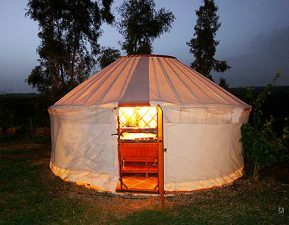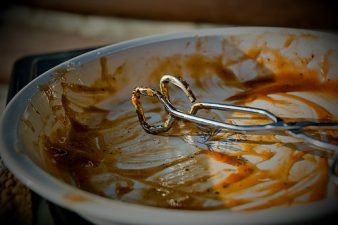 All the life of a sloth. Karin talks about all she knows on the Slow Food Movement.
All the life of a sloth. Karin talks about all she knows on the Slow Food Movement.
Have you ever had the pleasure of watching the life of a lazy sloth? In Costa Rica on the Pacific shore near a busy surfing village, I rented a room in a small hotel for a week. There I watched the slowness of a sloth with curiosity and envy. For days she sat perched above my balcony in a large tree chomping slowly on its leaves.
In the room beside me was a writer looking to complete his next novel, on the other side was a surfer waiting to catch the next big wave. I, on a break from university, was looking for enlightenment and love.
In the hopes of finding some answers I took interest in the sloth who appeared, unlike those around her, to have no great aspirations in life.
After 4 days of watching the sloth (it had barely moved except once when I wasn’t looking), she painstakingly lumbered down the tree in search of a place to defecate. The aspiring writer had told me this after I came home from dinner.
The sloth, he said, went down to do her business close to a favourite tree – the Cecropia – where she dug a hole, fertilized it, and as swiftly as she could, mustered enough energy to climb back up the tree.
We can blame it on a faster metabolism, maybe, but modern humans have adopted the lifestyle opposite to the sloth – we act as though faster is certainly better.
A quick coffee on the way to work, zapping our ready-made food in the microwave, and like lightning we speed across the sky in airplanes. Lately, we catapult our thoughts through cyberspace.
In modern times we eat fast, work fast, talk fast and even love fast.
But as we race ahead from one experience to the next and to dizzying heights, one must wonder, is doing things quickly the best way to drive our lives?
In little pockets around the globe, a group of people are saying it’s time to use the brakes, take life slow and take the time to smell the roses.
They call themselves members of the The Slow Movement. Believe it or not, you can even find them in Israel.
Adherents to the Slow Movement eschew fast travel, fast work, fast relationships and fast food: basically anything that threatens the connection to oneself, family, environment and creator.
“Think slow money, slow football, slow art, slow leadership, slow research, or slow email,” says Carl Honoré the author of the book, In Praise of Slowness.
On a recent vacation in Holland, Honoré wrote a blog entry describing the trip where he barged and cycled from one village to the next.
“Cycling offers the perfect speed,” says Honoré, “fast enough to cover lots of ground, slow enough to take in the details. In the evenings you can smell suppers cooking as you glide past the open kitchen windows.”
Smelling one’s supper and eating slowly, is one of the main motivations behind the founding of the Slow Movement.
About 20 years ago, an Italian named Carlo Petrini helped lead a protest against a fast food restaurant opening in a quiet piazza of his village.
With worries that the world was about to reach a place where certain cultural values connected to food could be lost forever, Petrini had another idea: to show consumers they have a choice about fast food and supermarket homogenization.
After convincing his friends, they started speaking out against golden arches and fast food. The Slow Food Movement was born.
Today, Slow Food is reported to have expanded its mission to 50 countries and 80, 000 people. And whether one is choosing basic ingredients, cooking, sharing a supper or masticating, every moment of that process, they say, should be taken slow.
There is no code book to follow, no one leader or organization dictating what is slow, in the same way there is no single organization telling us what is green and environmental. But Slow Food websites, books and printed material translated into dozens of languages can give you and your community ideas on taking it slow.
For some, it may mean taking the time to enjoy eating with others. For others being slow might be supporting locally grown organic agriculture and cuisine and buying products indigenous to your country or region.
On the other hand, going slow on the simplest level could be about the way you chew your food.
“My grandfather used to say eat your drink and drink your dinner,” says David B, whose grandfather from Morocco taught him that the healthiest way to approach one’s meal is through eating slowly. “He told me to chew my food 40 times before swallowing.”
Fairs spun off from the Slow Food Movement have also been cropping up in Italy, where local food fairs advertise the world’s largest “slow” food and wine fair – the Salone del Gusto in Genoa and Turin’s Terra Madre (“Mother Earth”) food meet.
Today Slow Food is officially headquartered in the north of Italy where the first national association was founded. And in America, Slow Food USA works as an educational organization to preserve the food traditions of North America, such as taking stock of Cajun spice recipes used in southern cooking.
“Some indigenous foods,” advertises Slow Food USA, “and the communities that produce and depend on them are constantly at risk of succumbing to the effects of the fast life, which manifests itself through the industrialization and standardization of our food supply and degradation of our farmland.”
By reviving the pleasures of the table, and using our tastebuds as our guides, Slow Food USA believes that our food heritage can be saved.
Is the sloth winking at us?
For more information about The Slow Food Movement in Israel, check out Slow Food in the Upper Galilee.
Don’t stop here. Green Prophet has a number of articles about food. See :: New Organic Restaurant in Tel Aviv and our wildly popular post :: Where to Buy Cheap Organic Food
(This article was first printed on EOLife.org/ Image credit etherase)




4 thoughts on “Slow Down, You Eat Too Fast (All About the Slow Food Movement)”
Comments are closed.